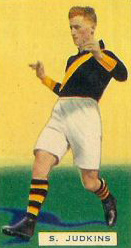Stan Judkins
| Stan Judkins | |||
|---|---|---|---|
 |
|||
| Personal information | |||
| Full name | Stanley Lucas Judkins | ||
| Date of birth | 4 October 1907 | ||
| Place of birth | Fitzroy, Victoria, Australia | ||
| Date of death | 17 October 1986 (aged 79) | ||
| Original team(s) | Greensborough/Northcote (VFA) | ||
| Debut | 1928, Richmond vs. Geelong |
||
| Height | 166 cm (5 ft 5 in) | ||
| Weight | 61 kg (134 lb) | ||
| Playing career1 | |||
| Years | Club | Games (Goals) | |
| 1928–1936 | Richmond | 133 (5) | |
|
1 Playing statistics correct to the end of 1936.
|
|||
| Career highlights | |||
|
|||
| Sources: AFL Tables, AustralianFootball.com | |||
Stan Judkins (4 October 1907 – 17 October 1986) was an Australian rules footballer who played for the Richmond Football Club in the Victorian Football League between 1928 and 1936. He became the first Richmond player to win the game's most prestigious award, the Brownlow Medal.
Judkins played his junior football as a rover for Greensborough and then moved to Northcote in the VFA for the 1926 season. Invited to Richmond the following year, Judkins was forced to remain in the VFA for one more season due to clearance problems, caused by a dispute between the two competitions. Eventually, he made his way to Punt Road in 1928, and he immediately became a first team regular, aged 20. He arrived at the club at the start of a golden era, and starred in the Tigers' semifinal win over Carlton, but was quiet during the loss to Collingwood in the Grand Final three weeks later.
A diminutive man at 166 cm and 61 kg, Judkins was a typical wing player of his era. At this time, teams generally used small, pacy men with good ground skills in the position. Judkins also earned praise for his handball and evasive ability; he was a hard man to tackle.
Judkins missed the Tigers' 1929 finals appearance due to injury, but started the next season in blistering form, which eventually petered out. Dropped from the side five weeks before the finals, Judkins languished in the seconds, unaware he was about to make history and change the way the game would decide its best player award. In 1924, the VFL instituted the Charles Brownlow Medal, to honour a recently deceased Geelong player and official. It was decided by the umpires, who gave a single vote to the player they believed to be the best afield. In 1930 the award carried little prestige – the winner was notified by mail and told to come and collect the award from the VFL office. Indeed, the concept of individual awards in a team game was only beginning to gain acceptance.
...
Wikipedia
